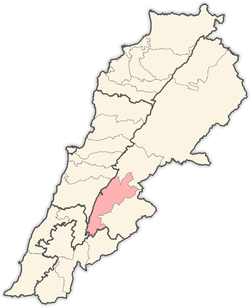Baaloul
| Baaloul بعلول (البقاع الغربي) Baalool | |
|---|---|
| Village | |
 Baaloul Location in Lebanon | |
| Coordinates: 33°35′23″N 35°45′2″E / 33.58972°N 35.75056°ECoordinates: 33°35′23″N 35°45′2″E / 33.58972°N 35.75056°E | |
| Country |
|
| Governorate | Beqaa Governorate |
| District | Rashaya District |
Baaloul (in Arabic بعلول, . Tr B'alūl ) is a town located in southeastern Lebanon, whose geographical location it is the eastern Bekaa Valley.
Baaloul is located in a remote area in the middle of mountainous areas. It limits the east with the people of Lela and west to the village of Karaoum. Its current population is approximately 200 native people from the village, considering that many residents living abroad. Its inhabitants are religionists Muslim Sunni, but also resides a family Christian Maronite in the community.
This town is known for being one of the many born of emigration from Lebanon. The first wave of migration that emerged in Baaloul was between 1935 - 1950, prior to Lebanese independence and during administration of the territory by France. The French Mandate of Lebanon exercised authority and take political and economic decisions in the territory. The French showed certain preferences to the community Christian Maronite, some discrimination to be reported to the Muslim. Lebanese Muslim men of the time were protesting the situation and claimed that they did not want to live in a country where decisions were exercised by foreigners over the Arab, this resulted in the displacement of these out of Lebanese territory.
The second displacement of its inhabitants began during the 70s, when the country was facing the beginning of a power struggle in the political and social field between the factions Muslim and Christian. Finally this struggle gave as a result the start of the Lebanese Civil War (1975 - 1990). The situation in the country was unstable and a sluggish economy and an increasingly bloody civil war that prevented raising their children; Many people decided to again begin to migrate.
The people emigrated mainly to countries of Latin America, among which are: Colombia, Venezuela, Brazil and Panama; there were also significant numbers who moved to Canada and US. These migrations are mostly round trips: after achieving a stable economic support the immigrant population Baaloul returns again to dedicate himself to building homes for their families.
Colombia it was one of the main destinations of emigration of people. Among the 70, 80 and 90 the Department of Colombian Guajira, specifically the population of Maicao was one of the places where the community was established. Today you can see a strong presence of migrants from Baaloul in the area.
Venezuela is another destination countries, with the Isla Margarita and the Economic Zone Paraguaná in the city of Punto Fijo where migrants are highly concentrated, focusing mainly trade dry goods.
Panama in the 80's and 90 received the community of Baaloul, which focused on the Colon Free Zone, on the outskirts of Panama Canal imposing a trade regime and business in the locality.
Brazil is one of the countries with the largest Lebanese communities around the world, even higher than the current population of Lebanon. Baaloul villagers are in the triple border Foz do Iguacu in the Province of Parana.
Today, the population is divided Baaloul and ranks twenty-four family names surnames. These families joined entirely to a population of more than 1,200 people.
The official language of Lebanon is Arabic, and as a second language French; however Baaloul the main language spoken by the community, both within the town and beyond this is the Spanish, given the number of emigrants to Spanish-speaking countries. After the Spanish the most widely used languages are Arabic, the English and Portuguese.
References
External links
- Baaloul, Localiban
